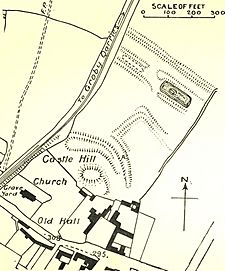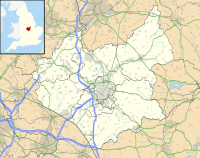Groby Castle facts for kids
Groby Castle is an old castle located in the large village of Groby. This village is found to the north-west of the city of Leicester in England. Today, only a few parts of the castle remain, mostly earth mounds and a small wall.
History of Groby Castle
After the Norman Conquest in 1066, a powerful Norman lord named Hugh de Grantmesnil took control of the Groby area. He owned many lands in Leicestershire, and Groby was one of them. Many historians believe that Hugh de Grantmesnil started building Groby Castle.
However, some experts think the castle was built later, around the mid-1100s. They believe it was built by the Earl of Leicester. Digs in the 1960s showed that the castle's main mound, called a motte, was built around a stone tower.
Castle Destruction and Later Use
Groby Castle was one of three castles that were destroyed by King Henry II. This happened after his son, Prince Henry, led a rebellion against him in 1173–1174. The king wanted to make sure these castles could not be used against him again.
In the 1200s, a stone manor house was built on the same spot. A manor house is a large country house, often the main house of a large estate. By the early 1600s, an old writer named William Burton said that Groby Castle was completely ruined. He noted that only the mounds, earth walls, and ditches could still be seen.
What Remains Today
Today, you can still see a small piece of one wall. There are also large earth mounds behind the house known as Groby Old Hall. Part of the castle site is now home to the church of St Philip and St James.
In the early 1960s, archaeologists dug at Groby Castle. This was done because the A50 road was going to be built nearby. The road passes close to the castle's main mound and destroyed some of its outer defenses. In 2010, the TV show Time Team also carried out excavations at the castle.
Groby Castle is a Scheduled Monument. This means it is a very important historical site. It is protected by law to make sure it is not damaged without permission.




